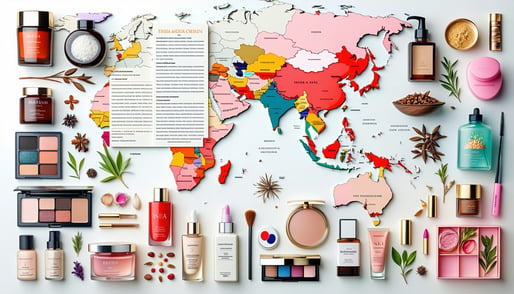The landscape of cosmetic regulation in the United States is a dynamic and important framework intended to protect consumer safety and product integrity. While some other parts of the world have more comprehensive pre-market regulations, the U.S., primarily under the authority of the Food and Drug Administration (FDA), has historically operated on a post-market basis, which means that products generally do not receive required approval prior to being on the store shelf (with some exceptions). However, recent legislative changes have granted the FDA even more authority and required new actions from the industry.
What Qualifies as Cosmetic in the USA?
The distinction between cosmetic products, drugs, and hybrid products is central to understanding U.S. cosmetic regulations. This classification dictates the specific regulatory requirements a product must meet.
FDA’s Legal Definition of Cosmetics under the Federal Food, Drug, and Cosmetic Act (FD&C Act)
The Federal Food, Drug, and Cosmetic Act (FD&C Act), which was passed in 1938, is the basis for cosmetic regulation in the United States. Section 201(i) of the FD&C Act states that cosmetics are "articles intended to be rubbed, poured, sprinkled, or sprayed on, introduced into, or otherwise applied to the human body...for cleansing, beautifying, promoting attractiveness, or altering the appearance." Cosmetics are defined broadly and include items such as skin moisturizers, perfumes, lipsticks, fingernail polishes, eye and facial makeup preparations, shampoos, permanent waves, and hair colors. The important factor here is the intended use of the product.
Difference between Cosmetics, Drugs, and Hybrid Products
The intended use of a product is the crucial differentiator between a cosmetic and a drug. The FD&C Act defines drugs as "articles intended for use in the diagnosis, cure, mitigation, treatment, or prevention of disease" and "articles (other than food) intended to affect the structure or any function of the body of man or other animals."
-
Cosmetics are intended to cleanse, beautify, promote attractiveness, or alter the appearance. They do not claim to affect the body's structure or function, nor do they treat or prevent disease.
-
Drugs, in contrast, are intended for therapeutic purposes, such as treating acne, alleviating pain, or preventing sunburn. They aim to alter the physiological structure or function of the body.
-
Hybrid Products: Many products can straddle both categories if they have dual intended uses. For instance:
-
If an anti-aging cream is hydrating the skin and improving its appearance, it is considered a cosmetic. However, if it claims to restore collagen production, or "repair skin at the cellular level," it is making drug claims because it clearly claims to affect the structure or function of a person's body.
-
A dandruff shampoo intended to clean the hair is a cosmetic product, but it also is a drug because it is intended to treat dandruff.
-
Sunscreen is one of the defining examples of a product regulated in the U.S. as a drug due to its intended use of providing some protection from the sun's harmful UV rays and preventing sunburn. Fluoride toothpaste is another defining example of a drug because its intended use is to prevent cavities.
-
When a product meets both cosmetic and drug definitions, it must comply with the regulatory requirements for both categories. The term "cosmeceutical" is often used in the industry to describe such products, but it holds no legal meaning under the FD&C Act; a product is either a cosmetic, a drug, or both.
Key Regulatory Authorities and Laws
The regulation of cosmetics in the USA is primarily managed by the Food and Drug Administration under several key legislative acts.
FDA
The U.S. Food and Drug Administration is the principal agency responsible for overseeing the safety and labelling of cosmetic products marketed in the United States. While the FDA historically has not required pre-market approval for cosmetic products or ingredients (with the exception of color additives), it holds significant authority to take action against adulterated or misbranded cosmetics once they are on the market. The FDA's responsibilities include setting standards, monitoring ingredients, inspecting manufacturing facilities, and enforcing labeling transparency.
FD&C Act
As previously mentioned, the Federal Food, Drug, and Cosmetic Act is the foundational law governing cosmetics. It defines what constitutes a cosmetic, outlines safety requirements, and empowers the FDA to regulate products that are adulterated or misbranded. The FD&C Act also prohibits the use of certain ingredients and places restrictions on others.
Fair Packaging and Labelling Act (FPLA)
Enacted in 1967, the Fair Packaging and Labelling Act is a federal law that aims to protect consumers by ensuring that labels on consumer commodities, including cosmetics, provide clear and accurate information. The FPLA requires cosmetic labels to clearly state:
-
The identity of the commodity.
-
The name and place of business of the manufacturer, packer, or distributor.
-
The net quantity of contents in terms of weight, measure, or numerical count, displayed prominently and in both metric and U.S. customary units.
The FPLA is designed to facilitate value comparisons and prevent deceptive packaging and labelling practices. The FDA enforces the FPLA for cosmetics.
Modernization of Cosmetics Regulation Act (MoCRA) 2022
The Modernization of Cosmetics Regulation Act of 2022 represents the most significant expansion of the FDA's authority to regulate cosmetics since the FD&C Act of 1938. MoCRA introduces several crucial new requirements for cosmetic manufacturers and responsible persons, significantly shifting the regulatory landscape:
-
Mandatory Facility Registration and Product Listing: For the first time, cosmetic product manufacturers and processors must register their facilities with the FDA and renew their registration every two years. Responsible persons must also list each marketed cosmetic product with the FDA, including product ingredients, and provide annual updates. Certain small businesses may be exempt from these requirements.
-
Adverse Event Reporting: Responsible persons are now required to report serious adverse events associated with the use of cosmetic products to the FDA within 15 business days. This includes a copy of the product label. Any new medical information received within one year of the initial report must also be submitted.
-
Safety Substantiation: MoCRA explicitly requires responsible persons to ensure and maintain records supporting adequate safety substantiation for their cosmetic products. While the law does not mandate specific tests, it places a clear responsibility on the industry to demonstrate product safety.
-
Good Manufacturing Practices: MoCRA mandates the FDA to establish regulations for Good Manufacturing Practices for facilities that manufacture or process cosmetic products, aiming to ensure product quality and safety during production.
-
Fragrance Allergen Labelling: The Act requires the FDA to establish regulations for fragrance allergen labelling requirements, enhancing transparency for consumers with sensitivities.
-
Mandatory Recall Authority: The FDA now has the authority to order a mandatory recall of a cosmetic product if it determines there is a reasonable probability that the product is adulterated or misbranded and its use or exposure will cause serious adverse health consequences or death, and the responsible person refuses to conduct a voluntary recall.
-
Asbestos in Talc: MoCRA requires the FDA to establish standardised testing methods for detecting and identifying asbestos in talc-containing cosmetic products.
MoCRA significantly strengthens the FDA's oversight of the cosmetic industry, moving towards a more proactive and stringent regulatory approach to enhance consumer safety.
Adverse Event Reporting and Recalls
The Modernization of Cosmetics Regulation Act of 2022 (MoCRA) significantly strengthened the FDA's ability to ensure cosmetic safety by mandating adverse event reporting and providing the agency with new recall authority.
Reporting Adverse Events (e.g., skin reactions, eye irritation)
Under MoCRA, "Responsible Persons" are now legally obligated to report serious adverse events associated with the use of their cosmetic products to the FDA. A "serious adverse event" is specifically defined to include outcomes such as:
-
Death
-
A life-threatening experience
-
Inpatient hospitalization
-
A persistent or significant disability or incapacity
-
A hereditary rarity or birth defect
-
An infection
-
Significant disfigurement, other than as intended under customary conditions of use.
-
An event that requires, based on reasonable medical judgment, a medical or surgical intervention to prevent an outcome described above.
For consumers and health professionals, the process for reporting adverse events, whether serious or non-serious, is primarily through the FDA's MedWatch program, using Form FDA 3500A. While non-serious events can be reported voluntarily, serious adverse events must be reported by the responsible person.
Record-keeping and Mandatory Reporting under MoCRA
MoCRA imposes stringent record-keeping and reporting obligations on responsible persons:
-
Serious Adverse Event Reporting: Responsible persons must report serious adverse events to the FDA within 15 business days of receiving the report. This submission must include a copy of the product label.
-
Follow-up Information: If the responsible person receives new medical or other relevant information about a serious adverse event within one year of the initial report, they must submit this updated information to the FDA within 15 business days of receipt.
-
Record Maintenance: Responsible persons are required to maintain records of all adverse events associated with their cosmetic products in the United States for a period of six years. For small businesses, this recordkeeping period is three years. These records must be readily accessible to the FDA upon request during inspections.
Recalls
Prior to MoCRA, the FDA did not have the authority to mandate cosmetic recalls, relying instead on voluntary recalls by manufacturers. MoCRA changed this, granting the FDA significant new power:
-
Mandatory Recall Authority: If the FDA determines that there is a reasonable probability that a cosmetic product is adulterated or misbranded and that its use or exposure will cause serious adverse health consequences or death, the agency can now order a mandatory recall. This authority is exercised if the responsible person refuses to conduct a voluntary recall or fails to do so within the timeframe set by the FDA. The FDA will notify the public of such recalls as appropriate.
-
Facility Registration Suspension: The FDA also gained the authority to suspend a facility's registration if the agency determines that a cosmetic product manufactured or processed by the registered facility has a reasonable probability of causing serious adverse health consequences or death to humans. A suspended registration means products from that facility cannot be introduced into interstate commerce.
These provisions are designed to enable the FDA to respond more swiftly and effectively to safety concerns related to cosmetic products in the market.
Importing and Selling Cosmetics in the USA
The importation and sale of cosmetics in the USA are subject to the same rigorous FDA regulations as domestically produced products, with additional considerations for international brands and manufacturers.
Requirements for International Brands and Manufacturers
International brands and manufacturers looking to sell cosmetics in the U.S. market must adhere to all applicable FDA regulations, including those newly introduced by MoCRA. Key requirements include:
-
Compliance with FD&C Act, FPLA, and MoCRA: This means ensuring product safety, accurate and compliant labelling and adherence to future Good Manufacturing Practices established by the FDA.
-
Facility Registration: Foreign facilities that manufacture or process cosmetic products for distribution in the U.S. must register with the FDA and renew their registration every two years, similar to domestic facilities.
-
Product Listing: The responsible person must list each cosmetic product marketed in the U.S. with the FDA and submit annual updates.
-
Responsible Person Contact Information: Product labels must include contact information for reporting adverse events. For foreign manufacturers, this typically means having a U.S. agent or distributor whose contact information is listed.
-
Safety Substantiation: Foreign manufacturers must also ensure and maintain records supporting adequate safety substantiation for their products, readily available if requested by the FDA.
-
Adverse Event Reporting: They are subject to the same mandatory serious adverse event reporting requirements as domestic entities.
Penalties for Non-Compliance
Non-compliance with FDA cosmetic regulations can result in a range of significant penalties and enforcement actions, designed to protect public health and ensure fair trade practices. These penalties can apply to manufacturers, distributors, or other responsible persons.
-
Warning Letters: The FDA's initial step for minor violations is often a Warning Letter, informing the responsible party of the violation and requesting corrective action. While not imposing immediate penalties, failure to adequately address the issues can lead to more severe actions.
-
Seizure of Products: The FDA can initiate a legal process to seize adulterated or misbranded cosmetic products that are in interstate commerce. This prevents the further sale and distribution of non-compliant products.
-
Injunctions: The FDA can seek court injunctions to compel companies to cease manufacturing or distributing non-compliant products until they meet regulatory requirements.
-
Civil Penalties: MoCRA introduced new civil penalty authorities. While specific monetary penalties are still being fully defined for all cosmetic violations, the FD&C Act generally allows for civil penalties for certain violations, which can be substantial. For instance, specific civil penalties are outlined for certain reporting failures related to drug samples, which, while not directly for cosmetics, illustrate the FDA's power to levy fines for non-compliance.
-
Criminal Prosecution: In cases of blatant or wilful violations, particularly those involving intent to defraud or mislead, or resulting in serious health consequences, the Department of Justice (DOJ) can pursue criminal prosecution against responsible individuals. This can lead to significant fines and imprisonment.
-
Import Refusals: For imported cosmetics, non-compliance means products will be refused entry into the U.S. and may be subject to re-exportation or destruction at the importer's expense.
-
Mandatory Recalls: As empowered by MoCRA, the FDA can now mandate recalls of products found to be adulterated or misbranded and posing a serious health risk, leading to significant financial burden and reputational damage for the responsible person.
-
Suspension of Facility Registration: A facility's registration can be suspended by the FDA if its products are deemed to pose a reasonable probability of causing serious adverse health consequences or death. This effectively blocks the facility from manufacturing or processing cosmetic products for distribution in the U.S.
-
Public Notification: The FDA may issue public warnings, safety alerts, or press releases to inform consumers about non-compliant or hazardous cosmetic products, leading to significant brand damage.
The strengthened regulatory framework under MoCRA underscores the FDA's commitment to ensuring cosmetic product safety and places a greater onus on the industry to uphold these standards, making proactive compliance more critical than ever.
Best Practices for Cosmetic Companies
To thrive under the updated cosmetic regulations, companies must proactively prioritize consumer safety. Implement robust Good Manufacturing Practices across all production stages, ensuring product quality and preventing contamination. Establish rigorous safety substantiation for every product, backed by scientifically sound data. Develop an efficient system for adverse event reporting and maintain meticulous records for all incidents. Ensure all product labeling is fully compliant with MoCRA, including new contact and allergen disclosure requirements. Invest in digital solutions to manage facility registrations and product listings with the FDA. Foster a culture of continuous learning and adaptation to stay ahead of evolving regulatory landscapes.
Final Thoughts
The Modernization of Cosmetics Regulation Act of 2022 marks a transformative era for cosmetic regulation in the United States. By significantly expanding the FDA's authority and introducing sweeping new requirements for facility registration, product listing, safety substantiation, adverse event reporting, and Good Manufacturing Practices, MoCRA has fundamentally reshape the landscape for cosmetic businesses.
This landmark legislation brings U.S. cosmetic oversight closer to the more stringent regulatory models seen in regions like the European Union, demonstrating a clear commitment to enhanced consumer safety and greater industry accountability. For companies operating in this sector, the era of limited pre-market oversight is definitively over.
Successful navigation of this new regulatory environment hinges not merely on reactive compliance, but on a proactive embrace of best practices. Companies that prioritise comprehensive safety assessments, meticulous record-keeping, robust quality management systems, transparent labeling, and continuous regulatory monitoring will be best positioned for long-term success. The penalties for non-compliance, now including mandatory recalls and facility registration suspensions, underscore the critical importance of these measures. MoCRA reinforces that consumer trust, built on a foundation of safety and transparency, is the cornerstone of a thriving cosmetic industry in the United States.
June 24, 2025



